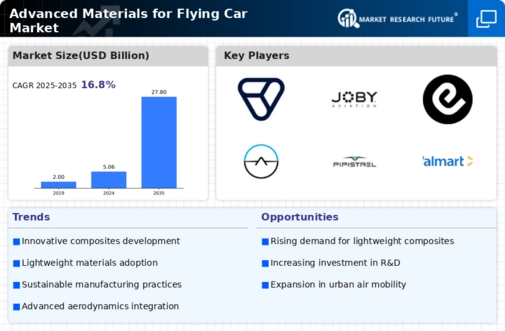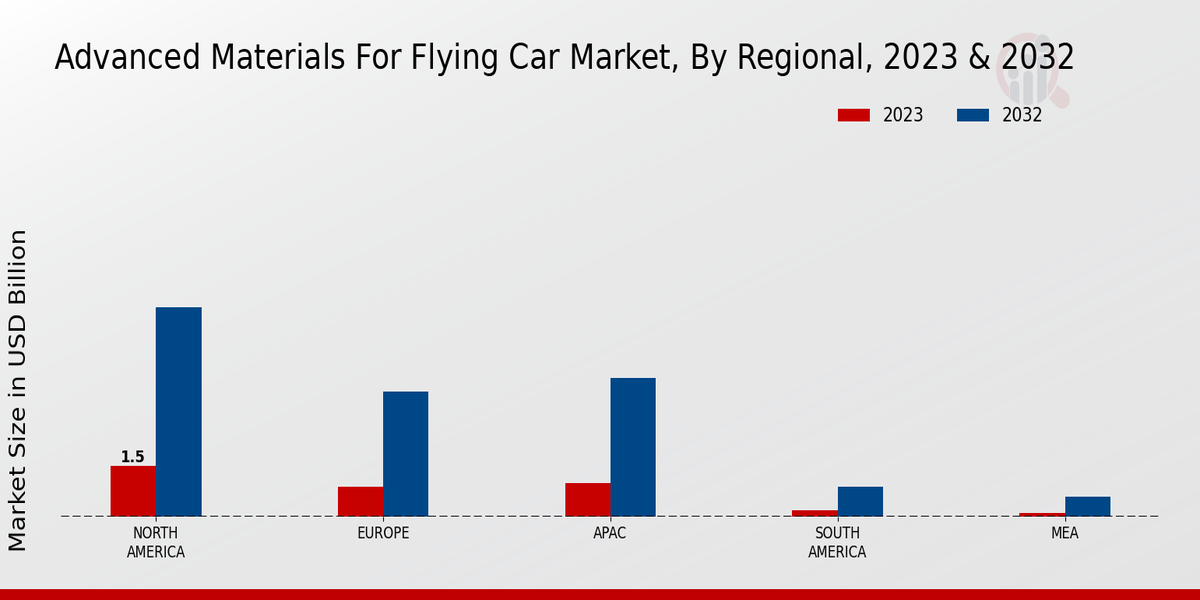Growing Demand for Urban Air Mobility
The Global Advanced Materials for Flying Car Market Industry is driven by the increasing demand for urban air mobility solutions. As urban populations expand, traditional transportation systems face congestion and inefficiencies. Flying cars present a viable alternative, offering rapid transit options that can alleviate traffic woes. The emphasis on reducing travel times in metropolitan areas is prompting investments in advanced materials that enhance the performance and safety of these vehicles. This trend is expected to propel the market from 5.06 USD Billion in 2024 to an estimated 27.8 USD Billion by 2035, as more cities explore the integration of flying vehicles into their transportation networks.
Investment in Research and Development
The Global Advanced Materials for Flying Car Market Industry is witnessing substantial investment in research and development initiatives. Companies are allocating significant resources to explore new materials that can enhance the performance, safety, and efficiency of flying cars. This investment is crucial for fostering innovation and ensuring that manufacturers remain competitive in a rapidly evolving market. Collaborative efforts between industry players and research institutions are yielding promising results, leading to the development of advanced materials with superior properties. As these innovations come to fruition, they are expected to play a pivotal role in the market's growth trajectory, supporting the projected increase from 5.06 USD Billion in 2024 to 27.8 USD Billion by 2035.
Technological Advancements in Materials
The Global Advanced Materials for Flying Car Market Industry is experiencing rapid technological advancements that enhance the performance and safety of flying vehicles. Innovations in lightweight composites, such as carbon fiber reinforced polymers, are enabling manufacturers to reduce weight while maintaining structural integrity. This is crucial as lighter vehicles can achieve better fuel efficiency and increased range. The integration of smart materials, which can adapt to environmental conditions, further enhances the functionality of flying cars. As these technologies evolve, they are expected to contribute significantly to the projected market growth from 5.06 USD Billion in 2024 to 27.8 USD Billion by 2035.
Sustainability and Environmental Considerations
The Global Advanced Materials for Flying Car Market Industry is increasingly influenced by sustainability and environmental concerns. As the world shifts towards greener technologies, the demand for materials that minimize environmental impact is rising. Advanced materials, such as bio-composites and recyclable metals, are gaining traction due to their lower carbon footprints. Manufacturers are focusing on developing flying cars that not only meet performance standards but also adhere to environmental regulations. This shift towards sustainable practices is likely to attract environmentally conscious consumers and investors, further driving market growth. The anticipated CAGR of 16.77% from 2025 to 2035 reflects this growing emphasis on sustainability.
Regulatory Support and Infrastructure Development
The Global Advanced Materials for Flying Car Market Industry benefits from increasing regulatory support aimed at facilitating the development of flying vehicles. Governments worldwide are establishing frameworks that promote innovation while ensuring safety standards. For instance, the Federal Aviation Administration in the United States is actively working on regulations that will govern the operation of urban air mobility vehicles. This regulatory clarity encourages investment in advanced materials that meet stringent safety requirements. As infrastructure for flying cars, such as vertiports and charging stations, develops, it is likely to stimulate market growth, contributing to a projected CAGR of 16.77% from 2025 to 2035.























